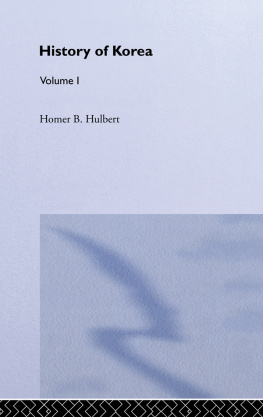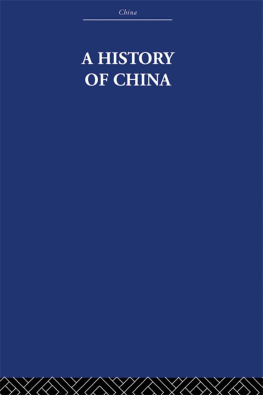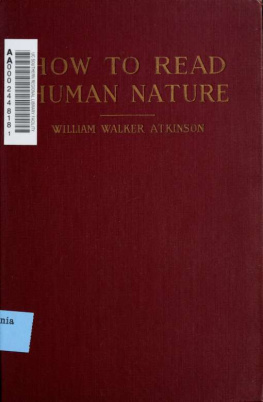HULBERTS HISTORY OF KOREA
Volume I

HOMER BEZALEEL HULBERT
A M , F R .G.S.
Was Born in New Haven, Vermont on January 26, 1863
Died in Seoul, Korea on August 5, 1949
HOMER B. HULBERT
History of Korea
Edited by
Clarence Norwood Weems
Volume I
First published 1905 by
RoutledgeCurzon
Published 2013 by Routledge
2 Park Square, Milton Park, Abingdon, Oxon OX144RN
711 Third Avenue, New York, NY 100017, USA
Routledge is an imprint of the Taylor & Francis Group, an informa business
1999 Weems Clarence Norwood
All rights reserved. No part of this book may be reprinted or reproduced or utilised in any form or by any electronic, mechanical, or other means, now known or hereafter invented, including photocopying and recording, or in any information storage or retrieval system, without permission in writing from the publishers.
British Library Cataloguing in Publication Data
A catalogue record for this book is available from the British Libra
ISBN 0 7007 0700 X (2 vol. set)
ISBN 978-0-700-70700-3 (hbk)
COMPOSITE TABLE OF CONTENTS
Headings with page numbers marked "ED" refer to new material written by the editor. All other captions refer to material found in Hulbert's original volumes, but they have been composed in brief form by the editor to avoid a repetition of Hulbert's extensive notes at the beginning of each of his chapters. The McCune-Reisohauer System is followed in romanizations in this table.
VOLUME I
HULBERTS TEXT
Chapter
Chapter
PART III: MODERN KOREA
(CHOSN OF THE YI DYNASTY)
Chapter
VOLUME II
PART III, MODERN HISTORY, CONTINUED)
Chapter
I The Hideyoshi War, Sixth Part
I-A The Hideyoshi War, Seventh Part
II The Hideyoshi War, Eighth Part
III Final Portion of the War and Subsequent Events, 1598-c. 1615
IV 1615 to c. 1623
V 1623 to 1627
VI 1627 to 1636
VII 1636 to 1637
VIII The Manchu Peace, 1637
IX 1637 to 1659
X 7659 to c. 1690
XI 1690 to 1743
XII 1743 to 1799
XIII 1799 to 1864
XIV Beginnings of the Reign of King Kojong (Emperor Kwangmu), 1864-1907
XV 1873 to 1882
XVI 1882 to 1888
XVII 1888 to 1894 and the Decisive Engagements of the Sino-Japanese War
XVIII Korea under Japanese Occupation, 1894
XIX More on 1894 and the King's "Reform Oath "January 5, 1895
XX Events leading to the Assassination of Queen Min, October 8, 1895
XXI From the Assassination to the King's Flight to the Russian Legation, February 11, 1896
XXII The King at the Russian Legation (February 1896 to February 1897)
XXIII 1897 to 1900
XXIV 1900 to 1902
XXV Events of 1902
XXVI 1903 through First Engagements of the Russo-Japanese War in February 1904
XXVII February-December 1904
GENERAL INDEX
BIOGRAPHICAL INDEX
Editor's General Note
CHRONOLOGICAL INDEX OF THE KINGS OF KOREA (WITH EDITORIAL COMMENTS)
THE KINGS OF MODERN KOREA
EDITOR'S REMARKS ON THE TABLE, "THE KINGS OF MODERN KOREA"
EDITORIAL NOTES TO VOLUME 11
EDITOR'S SUGGESTIVE BIBLIOGRAPHY
ILLUSTRATION
EDITOR'S CHART: MAJOR PRIMARY SOURCES
FOR KOREAN HISTORY
at end of Volume I
The suggestion made late in 1956 that I take the initiative in reviving Professor Hulberts book prompted two evenly balanced reactions. On the one hand, it was clear that the History enjoyed a continuing importance, if only by default; in the absence of any history of Korea of comparable coverage in a Western language, its refurbishment ought not to be delayed in anticipation of fresh writings in the field, including my own which are in preparation. On the other, it was equally plain that no responsible student could reintroduce this work today as a simple reprint. Indeed, indispensable explanations, additions and criticisms seemed to approach the proportions of a complete rewriting. As will be seen in the Editors Introduction, the authors sources were limited and often biased, and many of his specific findings are unacceptable in the light of recent research. He depended almost entirely on traditional Korean accounts of the early eras, without comparing them with Chinese histories written centuries closer to the event. Equally unfortunate is the fact that he wrote a catalogue of alleged occurrences, rather than a moving, coordinated survey of the many-sided life of a people.*
On balance, five considerations seemed to justify the major investment of time and energy required for an effective augmentation and annotation of the two volumes. First, a balance sheet of Korean historical scholarship, showing its major present resources and its remaining areas of uncertainty, would be valuable even if published separately, and still more usable if presented in company with Hulbert's pilot effort of more than half a century ago. Secondly, the early portions of the History are fairly faithful in conveying the old conventional view of their history held by Koreans, and this very fact makes it valuable to reproduce this version intact in order to examine both its verifiable and its unsupportable elements. Thirdly, the two hundred pages which the author devotes to the period of something over one hundred years running from the introduction of Catholicism in the late eighteenth century to the mid-point in the Russo-Japanese War at the end of 1904 are free of dependence on controversial early sources and make a major contribution to general Western knowledge. Fourthly, it was hoped that the Introduction and other substantive additions to be made to the History by the editor, with the generous aid of the Korean historical specialists of three continents, would in themselves enrich the reader's understanding of this neglected subject. Fifthly, the devotion of a substantial portion of the editorial addenda to the life and work of Homer Bezaleel Hulbert would give added depth and clarity to his own account of late-nineteenth-century developments, since he was an increasingly important actor in the Korean historical drama from 1886 to 1907, and was deeply concerned with Korea's problems until 1949.
After more than four years of joint labor, the editor is assured by his critics that these five features continue to have merit. I cannot fail, however, to recognize the shortcomings of this supplemented edition as finally presented. To the general reader who now lives in Korea or is otherwise interested primarily in recent and current developments there, it may appear that too much space has been given in the Editor's Introduction to fine points of ancient history. It must be observed that such emphasis seemed unavoidable in view of the questionable character of Hulbert's sources and outlook and in view of the archaeological and documentary data amassed during the past fifty years. At the same time, attention is called again to the fact that every available page has been used to paint as vividly as possible (in the Profile of Professor HuJbert) the portrait of a man whose life recalls a long series of events forming an integral part of Korean history as late as 1949. But other difficulties have also caused concern. The "Synthesis of Great Periods and Movements" in the Introduction deals with only seven of a possible fifteen or twenty topics. The Editorial Notes by no means provide an exhaustive criticism of Hulbert's detailed statements, and they are less logically grouped than if it had been practicable to separate substantive comments from notations referring to dates and transliterations. On the other hand, it is believed that this refurbished Hulbert approaches an optimal use of the pages which could be devoted to new material. It seems reasonable to hope that this modernized and enlarged presentation will offer all groups of Western-language readers a more comprehensive and accurate view of Korean history than has ever been open to them before and will also aid them in the exploration of useful books in all languages dealing with special problems.






